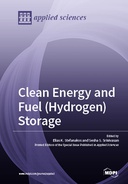Explore

Clean Energy and Fuel (Hydrogen) Storage
Sesha S. Srinivasan and Elias K. Stefanakos
2019
0 Ungluers have
Faved this Work
Login to Fave
Clean energy and fuel storage are often required for both stationary and automotive applications. Some of these clean energy and fuel storage technologies currently under extensive research and development include hydrogen storage, direct electric storage, mechanical energy storage, solar–thermal energy storage, electrochemical (batteries and supercapacitors), and thermochemical storage. The gravimetric and volumetric storage capacity, energy storage density, power output, operating temperature and pressure, cycle life, recyclability, and cost of clean energy or fuel storage are some of the factors that govern efficient energy and fuel storage technologies for potential deployment in energy harvesting (solar and wind farms) stations and onboard vehicular transportation. This Special Issue thus serves the need for promoting exploratory research and development on clean energy and fuel storage technologies while addressing their challenges to practical and sustainable infrastructures.
This book is included in DOAB.
Why read this book? Have your say.
You must be logged in to comment.
Rights Information
Are you the author or publisher of this work? If so, you can claim it as yours by registering as an Unglue.it rights holder.Downloads
This work has been downloaded 270 times via unglue.it ebook links.
- 57 - pdf (CC BY-NC-ND) at Unglue.it.
Keywords
- Ag nanoparticles
- anode
- aquifer size
- auxiliary services compensation
- bacterial sulfate reduction
- ball milling
- battery energy storage system
- binder
- bubbles burst
- bubbles transportation
- capacitance
- carbon materials
- carbonate gas reservoirs
- cathode
- charge density
- complex hydrides
- comprehensive incremental benefit
- concentrated solar power (CSP)
- conjugate phase change heat transfer
- crystal growth rates
- Diffusion
- dye-sensitized solar cells
- dynamic modeling
- electrical double layers
- electrochemical energy storage
- energy discharge
- equivalent loss of cycle life
- extended Kalman filter
- failure mode and effect analysis (FMEA)
- Fischer–Tropsch
- flow-induced vibration
- flutter instability
- four-point
- freestanding TiO2 nanotube arrays
- gas loss
- gas storage
- gas turbine engine
- heat transfer enhancement
- hot summer and cold winter area
- hydrogen absorption
- hydrogen energy storage
- Hydrogen Storage
- hydrogen storage systems
- internal and reverse external axial flows
- ionic liquid
- Klinkenberg method
- lab-scale
- large-scale wind farm
- Lattice Boltzmann method
- leaching tubing
- lean direct injection
- Li-ion batteries
- LiNH2
- lithium-ion batteries
- low emissions combustion
- Magnetism
- material science
- metal hydride
- methanogenesis
- MgH2
- nanocatalyst
- nanocomposite materials
- optimal capacity
- PCM roof
- PHREEQC
- Porous media
- Power to Liquid
- production rate
- quality function deployment (QFD)
- reactive transport modeling
- recovery factor
- regenerator
- rock permeability
- salt cavern
- salt cavern energy storage
- separator
- simplified electrochemical model
- slag
- state of charge estimator
- synthetic rock salt testing
- Thermal energy storage
- thermal energy storage (TES)
- thermochemical energy storage
- undercooling
- vertically oriented graphene
- water invasion
Links
DOI: 10.3390/books978-3-03921-631-4Editions


